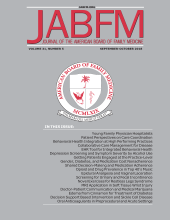Research ArticleOriginal Research
Understanding Implementation of Complex Interventions in Primary Care Teams
Thea Luig, Jodie Asselin, Arya M. Sharma and Denise L. Campbell-Scherer
The Journal of the American Board of Family
Medicine May 2018, 31 (3) 431-444; DOI: https://doi.org/10.3122/jabfm.2018.03.170273
Thea Luig
From Department of Family Medicine, University of Alberta (TL); Department of Anthropology, University of Lethbridge (JA); Department of Medicine, Division of Endocrinology, and Alberta Diabetes Institute, University of Alberta (AMS); Lifelong Learning and Physician Learning Program, Department of Family Medicine, and Alberta Diabetes Institute, University of Alberta (DLCS).
PhDJodie Asselin
From Department of Family Medicine, University of Alberta (TL); Department of Anthropology, University of Lethbridge (JA); Department of Medicine, Division of Endocrinology, and Alberta Diabetes Institute, University of Alberta (AMS); Lifelong Learning and Physician Learning Program, Department of Family Medicine, and Alberta Diabetes Institute, University of Alberta (DLCS).
PhDArya M. Sharma
From Department of Family Medicine, University of Alberta (TL); Department of Anthropology, University of Lethbridge (JA); Department of Medicine, Division of Endocrinology, and Alberta Diabetes Institute, University of Alberta (AMS); Lifelong Learning and Physician Learning Program, Department of Family Medicine, and Alberta Diabetes Institute, University of Alberta (DLCS).
MD, PhDDenise L. Campbell-Scherer
From Department of Family Medicine, University of Alberta (TL); Department of Anthropology, University of Lethbridge (JA); Department of Medicine, Division of Endocrinology, and Alberta Diabetes Institute, University of Alberta (AMS); Lifelong Learning and Physician Learning Program, Department of Family Medicine, and Alberta Diabetes Institute, University of Alberta (DLCS).
MD, PhD
References
- 1.↵
- Bhasker R
- 2.↵
- 3.↵
- Petticrew M
- 4.↵
- Campbell-Scherer D,
- Saitz R
- 5.↵
- Greenhalgh T,
- Robert G,
- Macfarlane F,
- Bate P,
- Kyriakidou O
- 6.↵
- 7.↵
- Helfrich C,
- Weiner B,
- McKinney M,
- Minasian L
- 8.↵
- Wandersman A,
- Duffy J,
- Flaspohler P,
- et al
- 9.↵
- Glasziou P,
- Meats E,
- Heneghan C,
- Shepperd S
- 10.↵
- Abell B,
- Glasziou P,
- Hoffmann T
- 11.↵
- Dal-Ré R,
- Bracken MB,
- Ioannidis JPA
- 12.↵
- 13.↵
- 14.↵
- Harvey G,
- Fitzgerald L,
- Fielden S,
- et al
- 15.↵
- 16.↵
- Meyers DC,
- Durlak JA,
- Wandersman A
- 17.↵
- Kaplan HC,
- Brady PW,
- Dritz MC,
- et al
- 18.↵
- Ferlie EB,
- Shortell SM
- 19.↵
- 20.↵
- Brodowski Ml,
- Counts JM,
- Gillam RJ,
- et al
- 21.↵
- 22.↵
- Collins C,
- Edwards A,
- Jones P,
- Kay L,
- Cox P,
- Puddy R
- 23.↵
- 24.↵
- 25.↵
- 26.↵
- 27.↵
- 28.↵
- Rapkin B,
- Weiss E,
- Lounsbury D,
- et al
- 29.↵
- 30.↵
- 31.↵
- Ogunleye A,
- Osunlana A,
- Asselin J,
- Cave A,
- Sharma AM,
- Campbell-Scherer DL
- 32.↵
- Osunlana AM,
- Asselin J,
- Anderson R,
- et al
- 33.↵The 5As Team Project [Internet]. [cited 2016 Apr 2]. Available from: http://www.obesitynetwork.ca/5As_Team.
- 34.↵
- 35.↵
- Asselin J,
- Osunlana AM,
- Ogunleye AA,
- Sharma AM,
- Campbell-Scherer D
- 36.↵
- Asselin J,
- Osunlana A,
- Ogunleye A,
- Sharma A,
- Campbell-Scherer D
- 37.↵
- Asselin J,
- Salami E,
- Osunlana AM,
- et al
- 38.↵
- Graham ID,
- Logan J,
- Harrison MB,
- et al
- 39.↵
- Brauer P,
- Connor Gorber S,
- Shaw E,
- et al
- 40.↵
- Gabbay J,
- Le May A
- 41.↵
- 42.↵
- Wenger E
- 43.↵
- May C,
- Finch T
- 44.↵
- 45.↵
- Denis J-L,
- Hébert Y,
- Langley A,
- Lozeau D,
- Trottier L-H
- 46.↵
- Minkler M,
- Wallerstein N
- 47.↵
- 48.↵
- Cornwall A,
- Jewkes R
In this issue
The Journal of the American Board of Family
Medicine
Vol. 31, Issue 3
May-June 2018
Understanding Implementation of Complex Interventions in Primary Care Teams
Thea Luig, Jodie Asselin, Arya M. Sharma, Denise L. Campbell-Scherer
The Journal of the American Board of Family
Medicine May 2018, 31 (3) 431-444; DOI: 10.3122/jabfm.2018.03.170273
Jump to section
Related Articles
- No related articles found.






